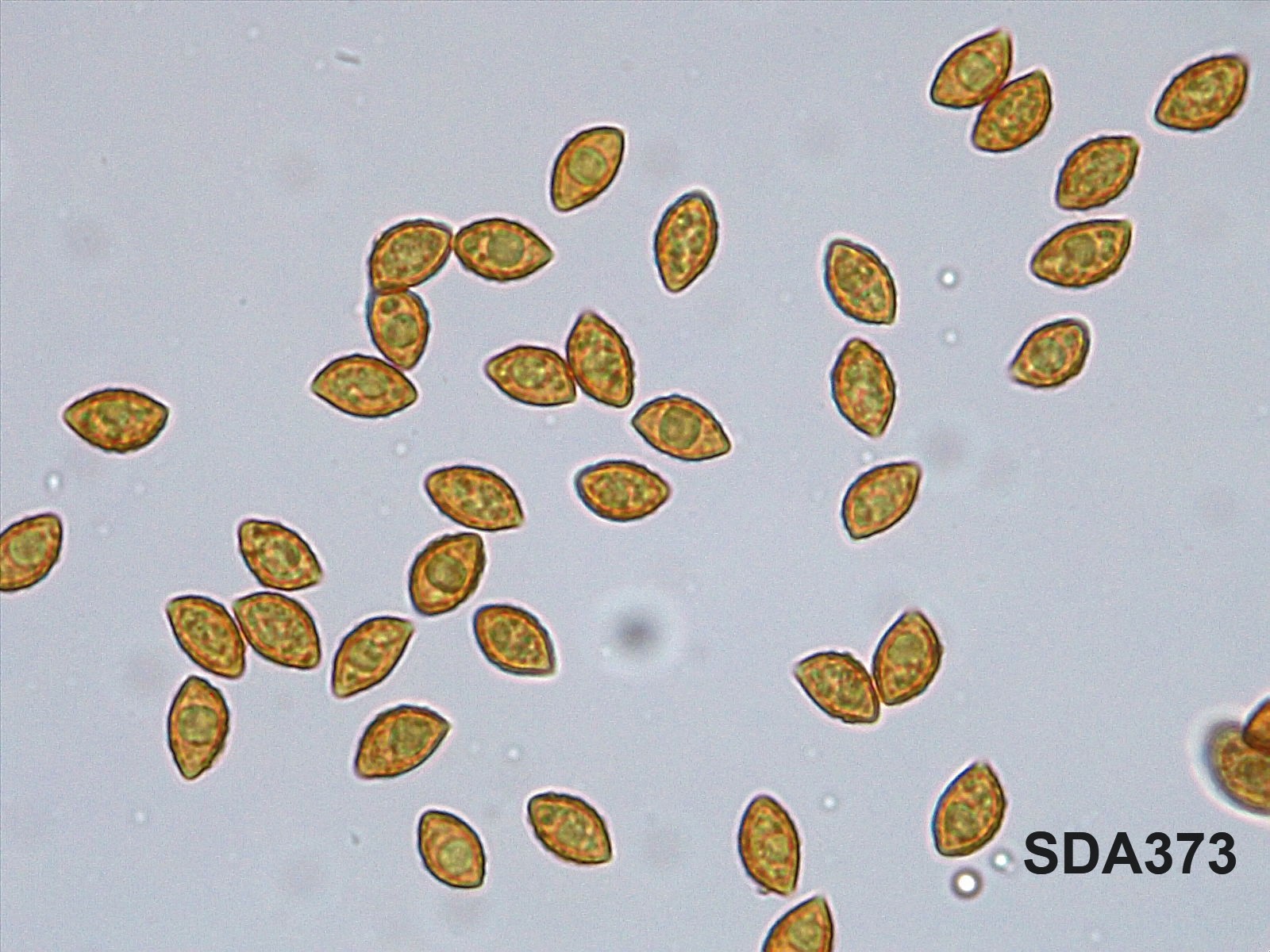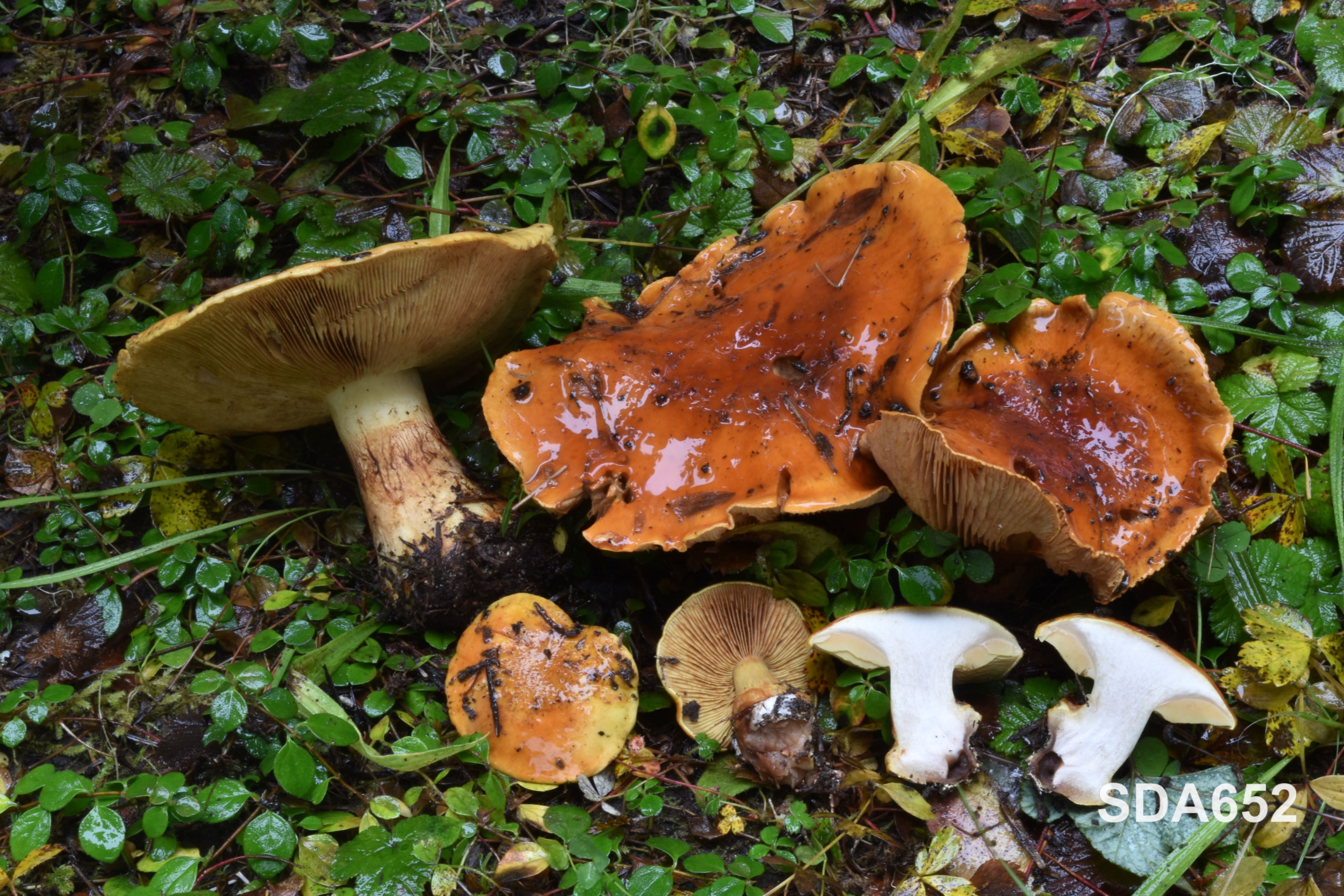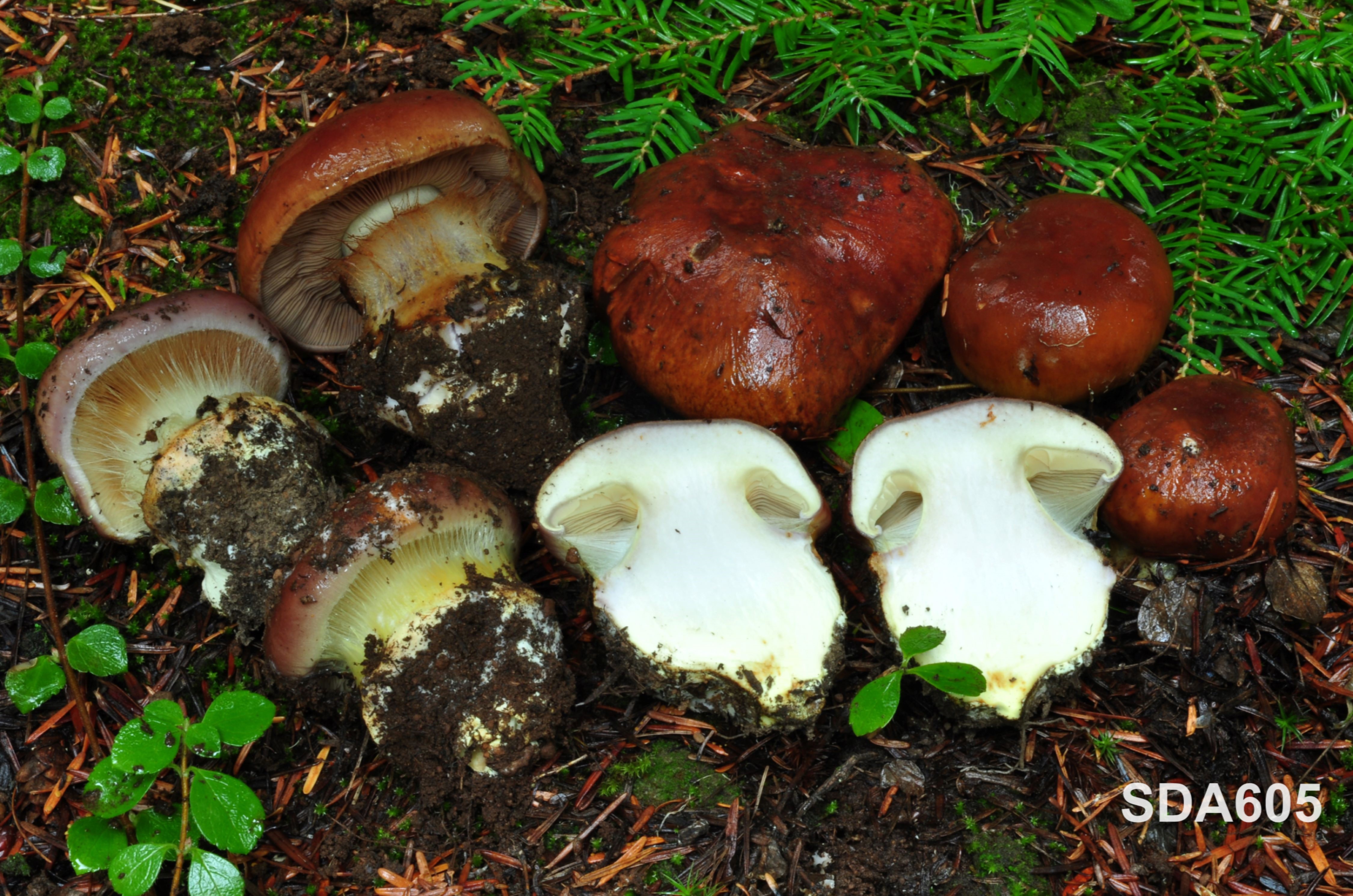Calonarius flavipavonius S.D. Adams, Bojantchev, N. Siegel, Liimat. & Niskanen (2023)
Reference: Index Fungorum 535
Description
Pileus 30–150 (–200) mm broad, convex to broadly convex, margin inrolled when young, remaining persistently down-curved through development, plane to uplifted and often undulating in age; surface viscid, glabrous; colors variable, rosy brown to rusty red-brown over disc to lilac towards margin, margin often with yellow glutinous veil, becoming ochre to vinaceous-brown in age. Lamellae narrowly adnate, close to crowded, moderately narrow; pale citrine yellow to yellow-olive when in button stage, soon yellow-clay colored, becoming light olivaceous brown as spores mature. Stipe 25–65 (75–) x 11–20 (–40) mm thick at apex, cylindrical to clavate to basal bulb; bulb rimmed and obliquely angled, (15–) 20–40 mm thick at widest part, covered with abundant cortina fibrils; off white, or blushed lilac to yellow at apex, covered with glutinous veil remnants. Cortina thick, cobwebby, pale yellow to whitish, leaving a thick annular zone on stipe. Flesh thick, firm, off-white to pale citron yellow, often with violet tones under cap cuticle and in bulb, developing yellow tones in stipe with age. Odor and taste indistinct. KOH deep maroon-red on cap and stipe base, slight purple on flesh near cap surface, and pale maroon purple in stipe base.
Microscopy: Basidiospores (290 spores, 10 collections), (8·5–) 9–11 (–11·5) x (4·5–) 5·0–6·5 (–7·0) µm, avg. 9·95 x 5·84 µm, Qr 1·47–2·02, Qa 1·71, citriform, moderately verrucose. Basidia 27–40 x 6·5–11 µm, avg. 34·1 x 8·64 µm, clavate, 4-spored. Pileipellis a duplex, a gelatinized layer of smooth to encrusted hyphae, 1·5–5·0 µm wide, with prominent clamp connections, pinkish buff to lilac in KOH, below this, a layer of ± cylindrical, interwoven hyphae grades into context, yellow, strongly pigmented lilac with oxidation in 3% KOH mounts. Exsiccata pileus brick red, stipe pale gray to cream.
Ecology and distribution: Solitary, scattered to gregarious on soil in conifer forests with Pseudotsuga menziesii, Tsuga spp., Abies spp., and Picea spp. in western North America. Producing basidiomata in autumn.
Photographs










Discussion
Calonarius flavipavonius is in subgenus Calonarius, section Calonarius. The general position is in the cedretorum clade and based on phylogenetic analysis it is rather isolated. The closest relatives are C. luteolus and C. odorifer with approximately 95.6% and 95.2% similarity, respectively, and more than 20 base pair differences. Another somewhat closely related species, based on Genbank BLAST matching, is the sequestrate C. saxamontanus with 96.36% similarity. The colors of mature specimens show similarity to Calonarius cupreorufus (=Cortinarius cupreorufus) but differ in the presence of rosy brown and lilac colors in young fruitbodies, a maroon KOH reaction, and glutinous yellow veil. Calonarius cupreorufus gills are a distinctive sulfur yellow, versus a paler citron yellow to yellowolive in Calonarius flavipavonius. Calonarius flavipavonius also shows some similarity to Calonarius cacodes (=Cortinarius cacodes) which lacks the maroon KOH reaction and the yellow coloration to young basidocarps.
Specimens
Specimens examined: USA. California. Sonoma County: Salt Point State Park, 0.5 mi. North of Hwy 1 (38.562862, -123.303346), under Notholithocaprus densiflorus, Pinus muricata, and Pseudotsuga menziesii, 20 Nov. 2009, D. Bojantchev, DBB26900, (WTU F-075685), GenBank OP739493. Tuolumne County: Yosemite National Park, off Tioga Pass Rd (37.812104, -119.527802), elev. 8110 ft, under Pinus ponderosa, Abies concolor, A. magnifica, and Pseudotsuga menziesii, 15 Oct. 2011, DBB46560, (WTU F-075687), GenBank OP799362. Montana: Lincoln County, Cabinet Mountains, off NF-278 Rd (48.202832, -115.578927), elev. 3553 ft. under Picea sitchensis, Picea engelmannii, Pseudotsuga menziesii, Tsuga mertensiana, 2 Oct. 2010, D. Bojantchev, DBB37369 (WTU F-075684), GenBank OP799363. Oregon, Hood River, Clear Lake turn-out from Hwy 126 (McKenzie Hwy) on approach to lake, by roadway with Pseudotsuga menziesii, Tsuga heterophylla and Abies spp. 13 Oct. 2019, S.D. Adams, SDA605, (WTU F-075680), GenBank OP739487. Washington, Chelan Co., Rainy Pass, trail to Lake Ann, 25 Sept. 2019, SDA562, (WTU F-075683), GenBank OP739488. King Co., Forest road 6830 spur, 0.4 mi before Tonga Ridge Trailhead, in young conifer forest of Abies amabilis, Abies lasiocarpa, Tsuga heterophylla, and Tsuga mertensiana, 8 Oct. 2018, S.D. Adams, SDA351, (WTU F-075678), GenBank OP739490. 9 Oct. 2018, N. Siegel, NS3337, (WTU F-075682), GenBank OP739492. 13 Oct. 2018, S.D. Adams, SDA373, (Holotype), GenBank OP739489. Pierce Co., Eatonville, Charles Lathrop Pack Experimental and Demonstration Forest, Regeneration Trail. 10 Oct. 2014, NAMA 2014-369 (as C.mikedavisii), (C0294349F), GenBank OP748992. Forest Road 45-10, Soda Springs Campground, mature conifer forest under Pseudotsuga menziesii, Tsuga heterophylla, and Abies spp. 23 Sept. 2018, S.D. Adams, SDA345, (WTU F-075677), GenBank OP739491. Mt. Baker-Snoqualmie National Forest, Buck Creek, mature conifer forest under Pseudotsuga menziesii, Tsuga heterophylla and Abies spp. 25 Oct. 2019, S.D. Adams, SDA652, (WTU F-075681), GenBank OP739486.
Etymology: Flavi refers to the predominant yellow colors, pavo for peacock referring to the range of secondary colors it exhibits.
Thanks
Thanks to supporters among family and friends and to the support of the PSMS grant and Stuntz Foundation which made sequencing possible.
References
Kare Liimatainen et al., “Taming the Beast: A Revised Classification of Cortinariaceae Based on Genomic Data,” Fungal Diversity 112, no. 1 (January 2022): 89–170, https://doi.org/10.1007/s13225-022-00499-9.
Index Fungorum no. 535Effectively published 22/05/2023 15:45:00 (ISSN 2049-2375)
Nomenclatural novelties : S.D. Adams, N. Siegel, D. Bojantchev, K. Liimatainen & T. Niskanen

Leave a comment